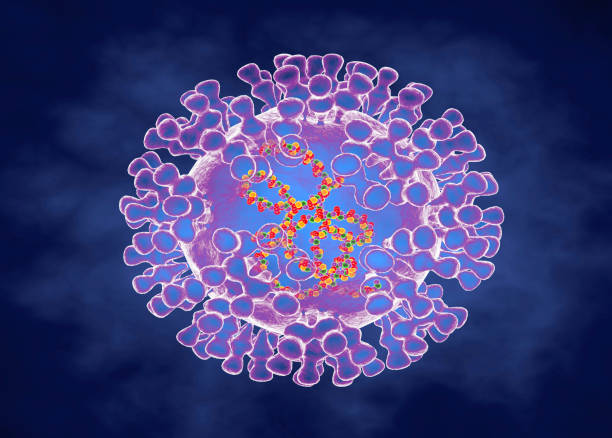Epstein Barr Virus.
PKGhatak, MD
The Epstein Barr virus was initially called the Burkitt lymphoma virus because the virus was identified in the cells of the Burkitt lymphoma in an African patient in 1964. It is known today as Human Herpes Virus 4. This virus is the most common viral infection among all other herpes virus infections in humans. About 85 % of the world population have serology positive blood for Epstein Barr Virus (EBV), indicating past infection.
EBV virus characteristics.
EBV belongs to Gamma-Herpesviridae in the genus group of Lymphocryptoviral. The double stranded genome contains 85 proteins and 50 non-coding RNAs. The viral particle has an outer lipid envelop which fuses with the respiratory cell membrane at the time of infection. The DNA of the virus can turn out 9 different molecules of Entry Proteins, gP 1 – 9, and use them to infect many other cell types of the patient.
The EBV virus, once inside the respiratory cells, multiplies by redirecting the host cell to duplicate virus particles. The virus then leaves respiratory cells and infects B-lymphocytes. Inside the B-lymphocytes, the virus persists for life and goes through 3 cyclic phases, namely active phase, dormant phase and re-infective phase.
A person infected with EBE is unable to clear the virus from his body. A subsection of B-lymphocytes is memory cells. The memory cells continue to turn out immunoglobulins, the initial product is IgM and 2 to 4 weeks later all the products are IgG.
In addition, antibodies are produced against capsular proteins and nuclear proteins.
Why does the EBV virus live in perpetuity in humans.
Whenever antibodies are produced in adequate amounts, the virus goes into hibernation within B-lymphocytes and also in some cases in the respiratory epithelial cells. The NK cells, monocytes and macrophages are unable to find the EBV once inside the cells and antibodies are ineffective to neutralize the viral particles. This hide and seek game is played out throughout the life of the patient.
In certain circumstances, the EBV can also infect NK cells, monocytes and macrophages and produces more serious illnesses.
EBV human infection.
Children are the prime target of the virus and about 80 % of human infections take place in children under 2 years old. Most of the infected children remain free of symptoms or had minor symptoms. The only evidence of infection in these cases is positive serology tests.
The next venerable age is teenagers. Teenagers, however, become symptomatic and the illness is known as Mononucleosis or simply Mono and also commonly called a kissing disease. The most remarkable symptoms are the posterior cervical lymph node enlargement and enlarged spleen. Other significant symptoms are sore throat, fever and enlarged tonsils.
Persistent and recurrent activation of EBV.
The EBV can become active within the immune cells, whenever the immune systems are down. The repeated reactivation of the EBV within the immune cells produces Multiple sclerosis and rheumatoid arthritis.
Reactivation within the respiratory epithelial cell leads to Sjogren syndrome and Systemic Lupus Erythematosus (SLE).
The positive ANA, pANCA, cANCA and Rh factor tests are the results of back and forth infections switching cell lines over a time.
In patients with seriously handicapped immune systems, the recurrence of active and inactive stages of EBV leads to B cell Lymphoma and Nasopharyngeal Carcinoma.
Systemic Autoimmune Disease (SADs).
A group of autoimmune diseases has one common factor of connective tissue damage. There are overlapping symptoms between these entities and often some positive serological tests are also common. The diseases are Mixed Connective Tissue Disease (MCTD), Myositis, Rheumatoid arthritis (RA). Systemic Sclerosis (SS), Lupus erythematosus (LE).
Autoimmune vasculitis of various clinical entities is associated with EBV infection.
Serology tests for EBE viral illness.
Mono spot test. And Heterophile antibody test.
Mono spot is no longer recommended for routine use for the diagnosis of mononucleosis in children because of false negative and some false positive results. But the science behind it is solid.
EBV produces antibodies which cross react with RBC antigen of horses and cows. This property of antibodies leads to the name of this test as Heterophile antibody test.
The heterophile antibody test is modified as a Mono slide test, available as a test kit and commonly used in clinics and pediatricians' offices. It is a modified and improved Paul-Bunnell test.
Immunofluorescence tests.
Viral Capsid Antigen (VCA) IgM Test.
The test is performed using antibodies tagged with fluorescence dye mixed with the patient's serum. A positive test is seen in about a week after infection and disappears in 4 to 6 weeks.
VCA IgG Test.
The test becomes positive in 2 to 4 weeks and then declines slightly and remains positive for the rest of the life.
Early Antigen Test (EA) Test.
Anti EA IgG antibodies appear during the acute phase of the infection and disappear in 3 to 6 months. In 20 % the Anti EA IgG may remain positive for a very long time, otherwise, an Anti EAIgG positive test indicates a recent infection.
EBV Nuclear Antigen Test.
It is also a fluorescence test against viral nuclear antigen that becomes positive in 2 to 4 months after infection and remains positive for the rest of life.
False Positive Heterophile Antibody Test.
False positive heterophile antibody results are seen in Viral hepatitis, Rubella, Toxoplasmosis, HIV/AIDS, Malaria, Lupus and Pancreatic Cancer.
A false negative Heterophile test is extremely rare in adults. Children do not readily produce Heterophile antibodies in the first two weeks following infection.
Blood Test.
The mononucleosis name is due to an increase in monocyte count in the peripheral blood. The total count increases only modestly in the range of 10,000 to 20,000. The lymphocyte count is generally over 50 %. And on the smear, Atypical lymphocytes appear.






